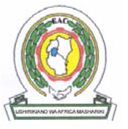
In order to promote public education and public safety, equal justice for all, a better informed citizenry, the rule of law, world trade and world peace, this legal document is hereby made available on a noncommercial basis, as it is the right of all humans to know and speak the laws that govern them.

EAS 221:2001
ICS 59.080.30
HS 6305.39.00
HS 6305.90.00
EAST AFRICAN COMMUNITY
© EAC 2001
First Edition 2001
iDevelopment of the East African Standards has been necessitated by the need for harmonizing requirements governing quality of products and services in East Africa. It is envisaged that through harmonized standardization, trade barriers which are encountered when goods and services are exchanged within the Community will be removed.
In order to achieve this objective, the Partner States in the Community through their National Bureaux of Standards, have established an East African Standards Committee.
The Committee is composed of representatives of the National Standards Bodies in Partner States, together with the representatives from the private sectors and consumer organizations. Draft East African Standards are circulated to stakeholders through the National Standards Bodies in the Partner States. The comments received are discussed and incorporated before finalization of standards, in accordance with the procedures of the Community.
East African Standards are subject to review, to keep pace with technological advances. Users of the East African Standards are therefore expected to ensure that they always have the latest versions of the standards they are implementing.
© East African Community 2001 — All rights reserved*
East African Community
P O Box 1096
Arusha
Tanzania
Tel: 255 27 2504253/8
Fax: 255-27-2504481/2504255
E-Mail: eac@eachq.org
Web: www.each.org
* © 2001 EAC — All rights of exploitation in any form and by any means reserved worldwide for EAC Partner States’ NSBs.
iiWoven bags (100 % sisal) for clean coffee beans — Specification
This East African Standard specifies the requirements for woven bags (100 % sisal) for clean coffee beans.
For the purpose of this East African Standard, the following definitions shall apply:
A long pale-cream hard fibre obtained from the leaf of a sisal plant (Agave Sisalana perrine) and other agave hybrids.
A coarse fabric made from sisal yarns
Warp yarns running along the length of the sacking and parallel to the sacking selvedge.
Weft yarns running across the width of the sacking and perpendicular to the sacking selvedge.
A rectangular, pressed, rigid package containing 100 per cent sisal bags, covered with a bale covering with the outer layer securely bound.
mass obtained by multiplying the nominal mass of a bag by the specified number of bags in that bale
The mass that a bag would have, if the recommended allowance for moisture in the bag was added to the oven-dry mass of the bag under standard atmosphere (see EAS 240*).
The mass of moisture in a bag expressed as a percentage of the oven-dry mass of the bag (see EAS 240).
The sacking shall be woven with uniform construction and shall comply with the requirements specified in Table 1 (d), (e), (f), (g), and (h).
* Titles of standards referred to are indicated at the back of this standard.
1Stitching thread — The stitching thread shall be 100% sisal. This shall be tested in accordance with EAS 255. The number of stitches per 10 cm shall be at least 8. The stitch line shall pass completely and continuously through all the folds of the sacking leaving no gaps in stitches.
Seams — The side seams of each bag (and the bottom seam, if any) shall be sewn in such a way that they (seams) comply with the requirements of Table 1 (d).
Hemming at the Mouth — The raw edges of the sacking at the mouth of each bag shall first be turned over to a depth of at least 1.5 cm with double fold and shall be firmly hemmed with the stitching thread.
Freedom from defects — The sacking shall be free from defects such as holes, cuts, tears, floats, crushed selvedges, spots and stains. The bag shall be free from sewing defects such as gap stitches, loose ends and frayed ends.
| Characteristic | Requirement | Tolerance | Method of test |
|---|---|---|---|
| (a) Dimensions of a bag for a 60 kg load cm (i) Inside length (ii) Inside width |
96 70.0 |
+2 −0 +2 −0 |
EAS 259 |
| (b) Mass per bag in grams | 1 100.00 | +50 −0 |
EAS 259 |
| (c) Breaking load of seam in Newtons | 1100 | - | EAS 259 |
| (d) Ends per 10 cm (Minimum) | 24.0 | - | EAS 259 |
| (e) Picks (shots) per 10 cm (i) Single (ii) Double |
26 34 |
EAS 259 | |
| (f) Breaking load of sacking in Newtons (20 cm × 5 cm strips (i) Warp-way (Minimum) (ii) Weft-way (Minimum) |
1100 1100 |
- - |
EAS 259 |
| (g) Moisture regain(Maximum) | 14 per cent | - | EAS 259 |
| (h) oil content on dry de-oiled material (Maximum) | 5 per cent | - | EAS 246 |
The following information shall be marked on each bale with indelible ink with all letters and figures not less than five (5) centimetres in height:
When a complete-filled sisal coffee bag is dropped from a height of 3 metres and lands on either of the faces, or either of the ends or either of the sides, it shall not burst. This shall be tested in accordance with EAS 259.
2Standards referred to:
| EAS 240 | Condition for the testing of textiles |
| EAS 255 | Methods for the quantitative chemical analysis of binary fibre mixtures |
| EAS 259 | Methods of test for complete, filled transport packages — Woven bags |
| EAS 246 | Method for determination of added oil content of sisal or jute yarn or fabric |